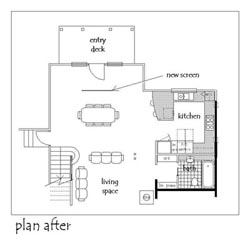Choosing the right privacy screen - 5 easy steps
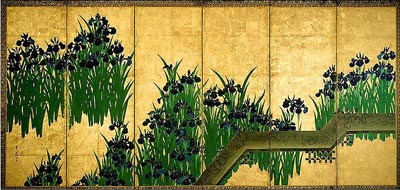
Traditional six-panel Byobu screen from Japan
Decorative screens have a history dating back to the mid-600's in China. During the 1950's and 1960's Australia saw a strong revival in decorative privacy screens in residential and commercial architecture. Today we are enjoying another revival with strong traditional designs implemented with contemporary styles and materials.
History
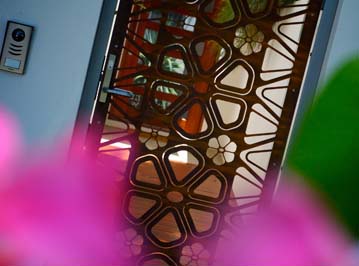
Weathered steel laser-cut outdoor piece
The two screen types that are heavily influencing are the byobu folding-panel screen from Japan and the Arabic mashrabiya, which is a lattice work screen of carved wood. After hundreds of years these traditional screens continue to inspire designers the world over with their exciting design and detail.
So what type of screen is right for your space? Read the rest of this article for an easy 5 step guide.
Step 1 - Analyse your space
Be clear about what you are trying to screen - is it just visual or is it acoustic as well? Create a list of requirements your screen must meet. The list may include points such as:
Here is an example:
- must reduce noise
- must match the lounge suite
- should screen view - not block the view
- should be a sculptural piece * fixed to floor and ceiling with tension wires - not free standing
- 1800mm wide x 1800mm high.
Most screen companies have in-house designers but if you prefer an independent opinion engage an interior designer or an architect to ensure that your requirements are met.
Entry spaces can really benefit from the use of privacy screens and this is one area where they are becoming more and more popular. Here is an example of how a privacy screen can be used in a typical home entry space.
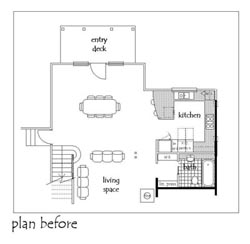
The screen marked in the 'after' plan redefines the space
The entry space in the "before" plan above is typical of many poorly designed homes. The home has a large open plan space but it is too open and offers little privacy from the entry area. By installing a simple 1800mm-wide screen, as shown on the 'after' plan, the private areas of the home are now screened and protected from direct view. This instantly improves the feng shui of the home and helps frame the entry space.
Decorative privacy screens can be used to divide large open plan spaces to create 'visual' rooms. They can also be used to form an acoustic ceiling or wall panelling in high noise areas.
Step 2 - Form a solid design idea
There are many graphic styles and concepts to choose from, so think about which style would best suit the interior look and feel of your home. A screen is a sculptural piece which you can style in a truly personal way; you may even wish to have a family portrait laser-cut into the design.
If you do not have a design concept or idea in mind don't worry as you'll find plenty of ideas at the Cutout web site. For their full range of illustrative designs and patterns intended for laser cut concepts. Or try our DIY interior design article to help get you started.
Step 3 - Know your screen material options
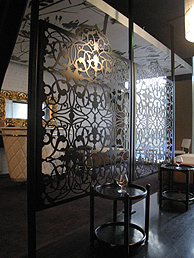
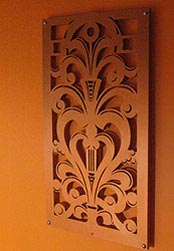
Mild steel screen on the left. MDF panel on the right.
Today's material options and styles are many, and seeing modern architectural materials meeting with traditional concepts is nothing short of amazing. Contemporary materials can include:
MDF
MDF stands for medium density fibreboard, which is a compressed wood, timber and glue product sold in varying sheet thickness. MDF can be laser cut quickly and thickly and as it is lightweight it is very easy to install. This creative wooden material can also be used in cabinetry work and is a fantastic medium for laser cut decorative screens inside the home.
Weathered steel
Architects love weathered steel. It can look stunning in residential architecture. It has a few different names, including "CorTen" and "rusted steel". The product has been intentionally altered to quicken the rusting effect. But whatever you call it, this product is just plain beautiful. If you do use it internally, you must ensure it does not come in contact with water as this will cause rust staining. If you are thinking about using weathered steel externally, ensure the screen can drip into a pond or onto grass or a material that is complemented by rust staining.
Plastic and Acrylic
When it comes to these products there is a wide variety of colours, finishes and textures available.
Metal
Screens can pretty much be made of any kind of sturdy construction sheeting, including smooth mild steel, patterned stainless steel, copper and powder coated aluminium. All metal forms are readily laser cut and provide the strength required for intricate designs and pattern work.
Step 4 - Think about screen maintenance
There are some screen materials that require some care, MDF for example, can be highly absorbent if placed in a moisture rich environment, and can soak up moisture like a sponge. CorTen is a rust-coated steel, so only install it where you know you can can prevent its rusting patina causing unwanted staining and damage to other materials.
Step 5 - Compare costs and quality
Of all the materials mentioned above the Acrylics, Stainless steel and Aluminium installations are the most expensive. The most economical product would be the MDF as it is light and easy to work with in comparison to steel.
External privacy screens
External privacy screens are a more recent phenomenon than the decorative indoor privacy screens described in this article. They began to appear in Australian residential and commercial building during the 1950's and 1960's, as a direct result of high density living and higher incomes.
For more information and some examples read our External Privacy Screens article.

